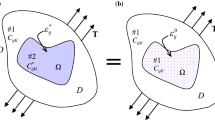Abstract
An inclusion of purely dilatational eigenstrain in an infinitely extended isotropic elastic matrix, independently of its shape, causes a deviatoric stress field around it. The present paper analyses the energy and volume changes due to the formation of a circular inhomogeneity in a deviatoric stress field coming from a circular inclusion of dilatational eigenstrain. It is found that the elastic stress inside the inhomogeneity remains deviatoric and the inhomogeneity formation does not change the volume of the inclusion-matrix system; it is argued that the same occurs for any inclusion shape and non-uniform eigenstrain. The elastic energy changes occurring in the domains occupied by matrix, inhomogeneity, and inclusion are calculated, and its dependence on the elastic properties and geometrical parameters of inhomogeneity and matrix is numerically investigated. Strengthening effects of the matrix-inhomogeneity system are examined by means of the energy force and expanding moment acting on the inhomogeneity.








Similar content being viewed by others
References
Bitter, F.: On impurities in metals. Phys. Rev. 37, 1527 (1931)
Goodier, J.N.: On the integration of thermo-elastic equations. Philos. Mag. 23, 1017–1032 (1937)
Robinson, K.: Elastic energy of ellipsoidal inclusion in an infinite solid. J. Appl. Phys. 22, 1045–1054 (1951)
Nabarro, F.R.: Inclusion and inhomogeneities under stress. Philos. Mag. Lett. 73, 45–50 (1996)
Muskhelishvili, N.I.: Some Basic Problems of the Mathematical Theory of Elasticity. (trans. JRM Radok) Noordhoff (1953)
Kattis, M.A., Meguid, S.A.: Two-phase potentials for the treatment of an elastic inclusion in plane thermoelasticity. J. Appl. Mech. 62, 7–12 (1995)
Hill, R.: The elastic behaviour of a crystalline aggregate. Proc. Phys. Soc. Lond. Sect. A 65, 349–354 (1952)
Bilby, B.A.: On the interactions of dislocations and solute atoms. Proc. Phys. Soc. A 63, 191 (1950)
Dundurs, J., Mura, T.: Interaction between an edge dislocation and a circular inclusion. J. Mech. Phys. Solids 12, 177–189 (1964)
Smith, E.: The interaction between dislocations and inhomogeneity-I. Int. J. Eng. Sci. 6, 129–143 (1968)
Hutchinson, J.W.: On Steady Quasi-Static Crack Growth. Harvard University Rep. Division of Applied Sciences (1974). DEAP S-8
Eshelby, J.D.: The force on an elastic singularity. Philos. Trans. R. Soc. A 244, 87–112 (1951)
Eshelby, J.D.: Energy relations and energy momentum tensor in continuum mechanics. In: Kanninen, M.F., Alder, M.F., Rosenfield, A.R., Jaffe, R.I. (eds.) Inelastic Behavior of Solids. McGraw-Hill, New York (1970)
Guell, D.L., Dundurs, J.: Further results on center of dilatation and residual stresses in joined elastic half-spaces. Developments in Theoretical and Applied Mechanics, Proceeding of the Third Southeastern Conference on Theoretical and Applied Mechanics, pp. 105–115 (1967)
Barnett, D.M.: On nucleation of coherent precipitates near edge dislocations. Scr. Metall. 5, 261–266 (1971)
Barnett, D.M., Lee, J.K., Aaronson, H.I., Russell, K.C.: The strain energy of a coherent ellipsoidal precipitate. Scr. Metall. 8, 1447–1450 (1974)
Yu, H.Y., Sanday, S.C.: Elastic fields in joined half-spaces due to nuclei of strain. Proc. R. Soc. Lond. A 434, 503–519 (1991)
Onaka, S., Fujii, T., Kato, M.: The elastic strain energy of a coherent inclusion with deviatoric misfit strains. Mech. Mater. 20, 329–336 (1995)
Onaka, S.: Elastic strain energy due to deviatoric eigenstrains in an inclusion having symmetric shape. Philos. Mag. Lett. 85, 115–123 (2005)
Seo, Y., Jung, G.-J., Kim, I.H., Pak, Y.E.: Configurational forces on elastic line singularities. J. Appl. Mech. 85, 034501 (2017)
Lubarda, V.A.: Interaction between a circular inclusion and a circular void under plain strain conditions. J. Mech. Mater. Struct. 10, 317–330 (2015)
Lubarda, V.A.: Circular inclusion near a circular void: determination of elastic antiplane shear fields and configurational forces. Acta Mech. 226, 643–664 (2015)
Kattis, M.A., Karalis, N.T.: Elastic energies in circular inhomogeneities: imperfect versus perfect interfaces. J. Elast. 111, 131–151 (2013)
Dundurs, J., Markenscoff, X.: Invariance of stresses under a change in elastic compliances. Proc. R. Soc. Lond. A 443, 289–300 (1993)
Eshelby, J.D.: The determination of the elastic field of an ellipsoidal inclusion and related problems. Proc. R. Soc. A 241, 376–396 (1957)
Milne-Thomson, L.M.: Theoretical Hydrodynamics. MacMillan, New York (1968)
Dundurs, J.: Some properties of elastic stresses in a composite. In: Proceedings of the 6th Annual Meeting of the Society of Engineering Science, vol. 5, pp. 203–216 (1970)
Author information
Authors and Affiliations
Corresponding author
Additional information
Publisher's Note
Springer Nature remains neutral with regard to jurisdictional claims in published maps and institutional affiliations.
APPENDIX
APPENDIX
Basic relationships
Muskelishvili’s relationships are [5]:
The complex potentials of the inhomogeneity and matrix in terms of their two-phase potentials \(\varphi _0 (z)\), \(\psi _0 (z)\) [23] are:
and
where
are two-phase parameters alternative of those of Dundurs [27].
Rights and permissions
About this article
Cite this article
Kattis, M.A., Gkouti, E. & Papanikos, P. Energy and volume changes due to the formation of a circular inhomogeneity in a residual deviatoric stress field. Acta Mech 230, 3457–3475 (2019). https://doi.org/10.1007/s00707-019-02469-w
Received:
Published:
Issue Date:
DOI: https://doi.org/10.1007/s00707-019-02469-w



